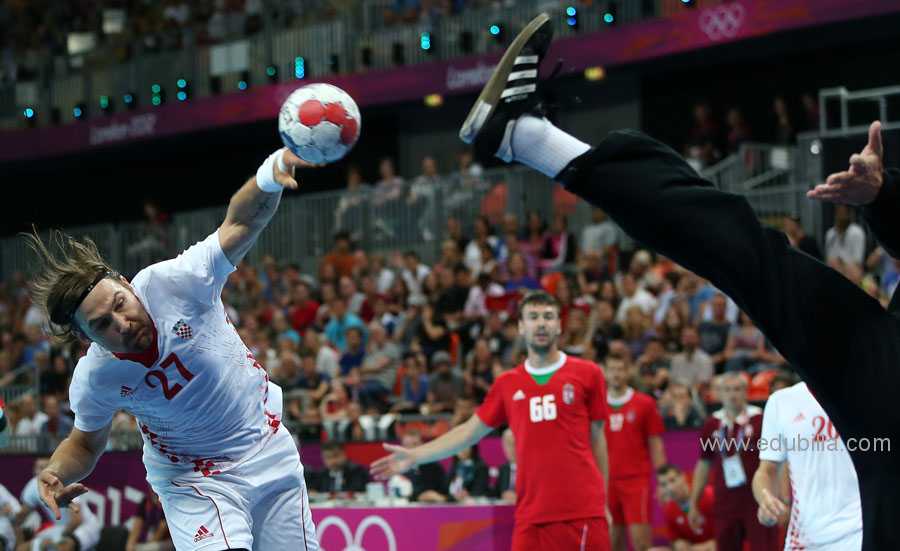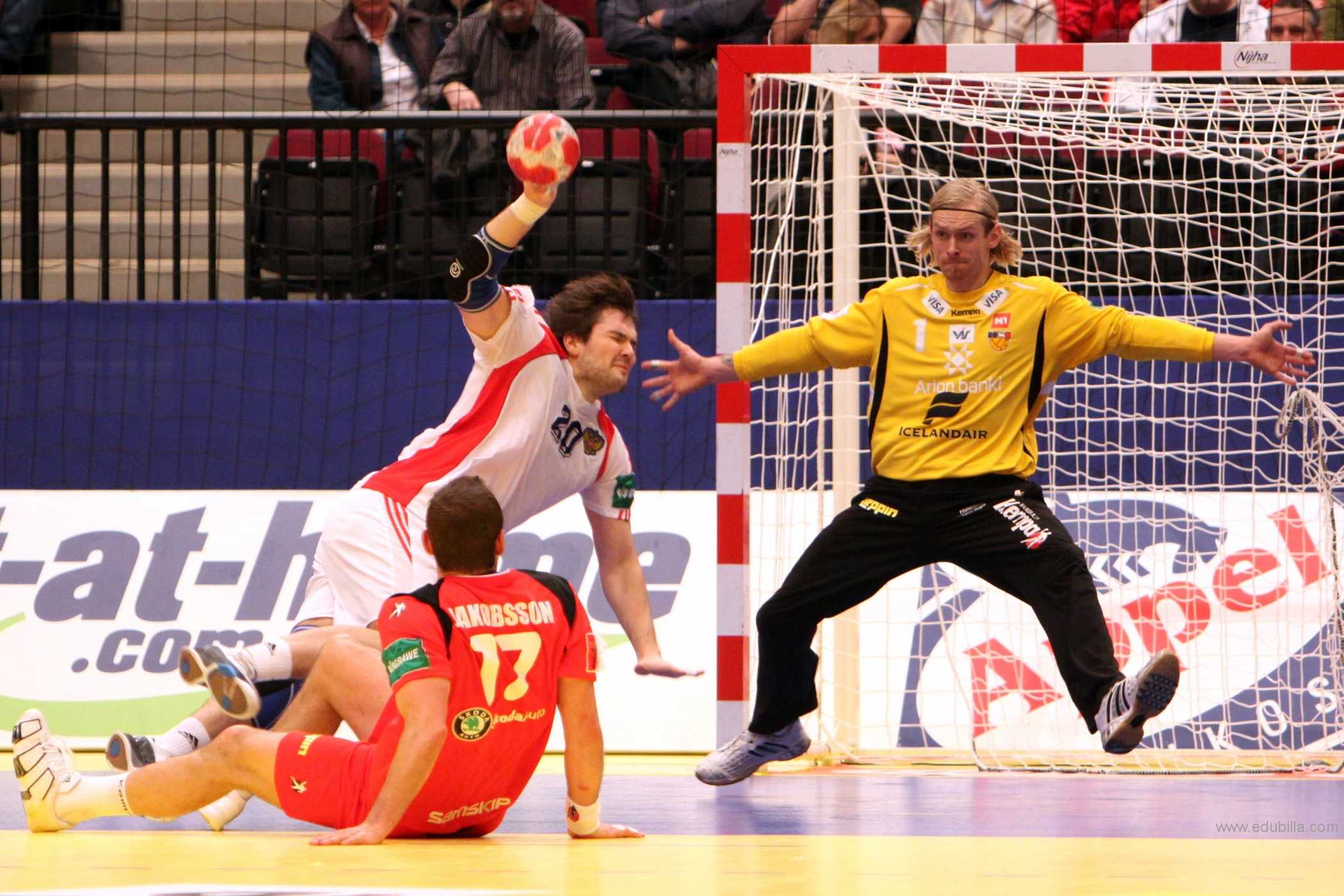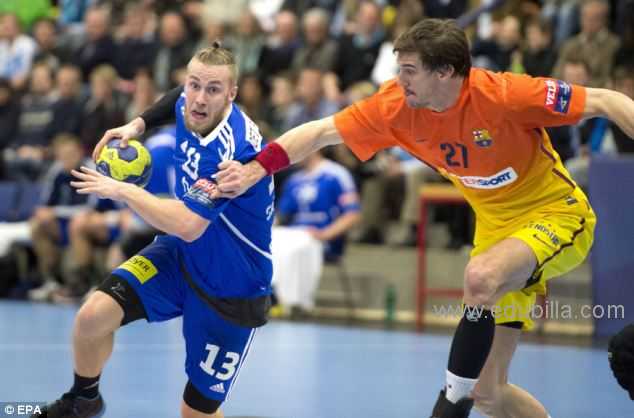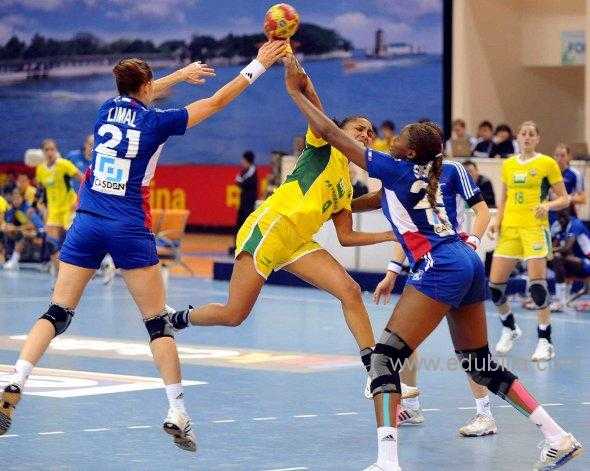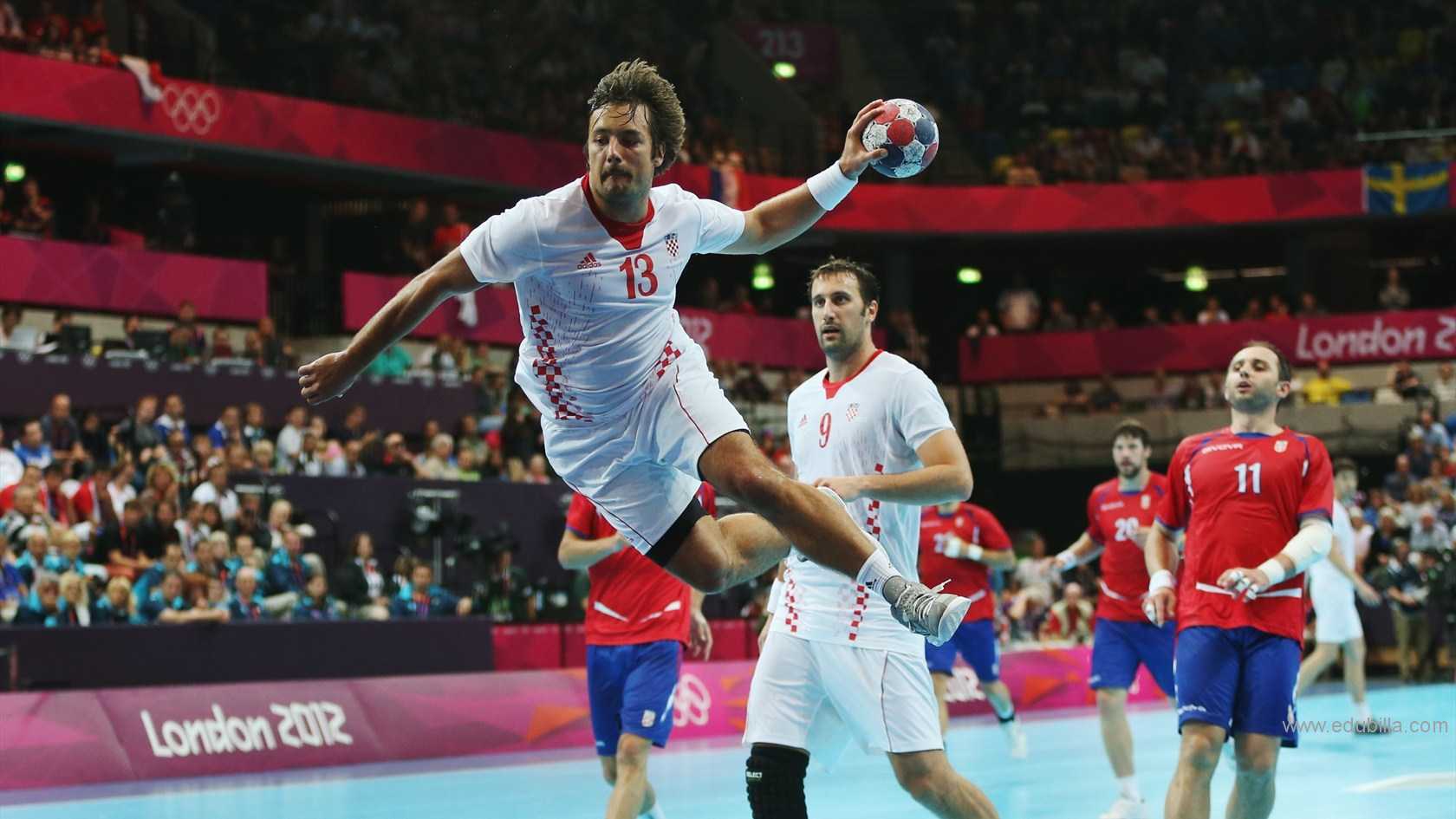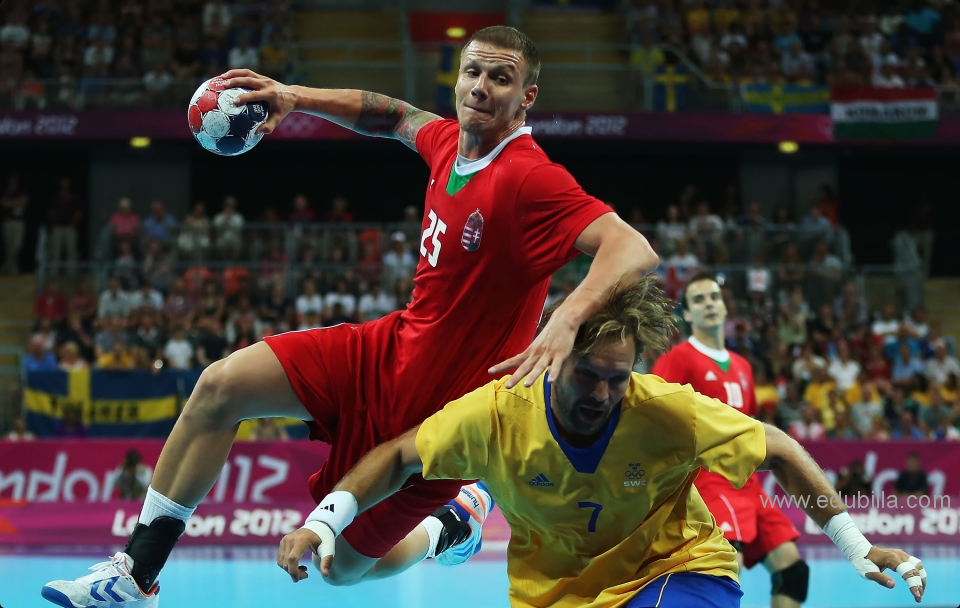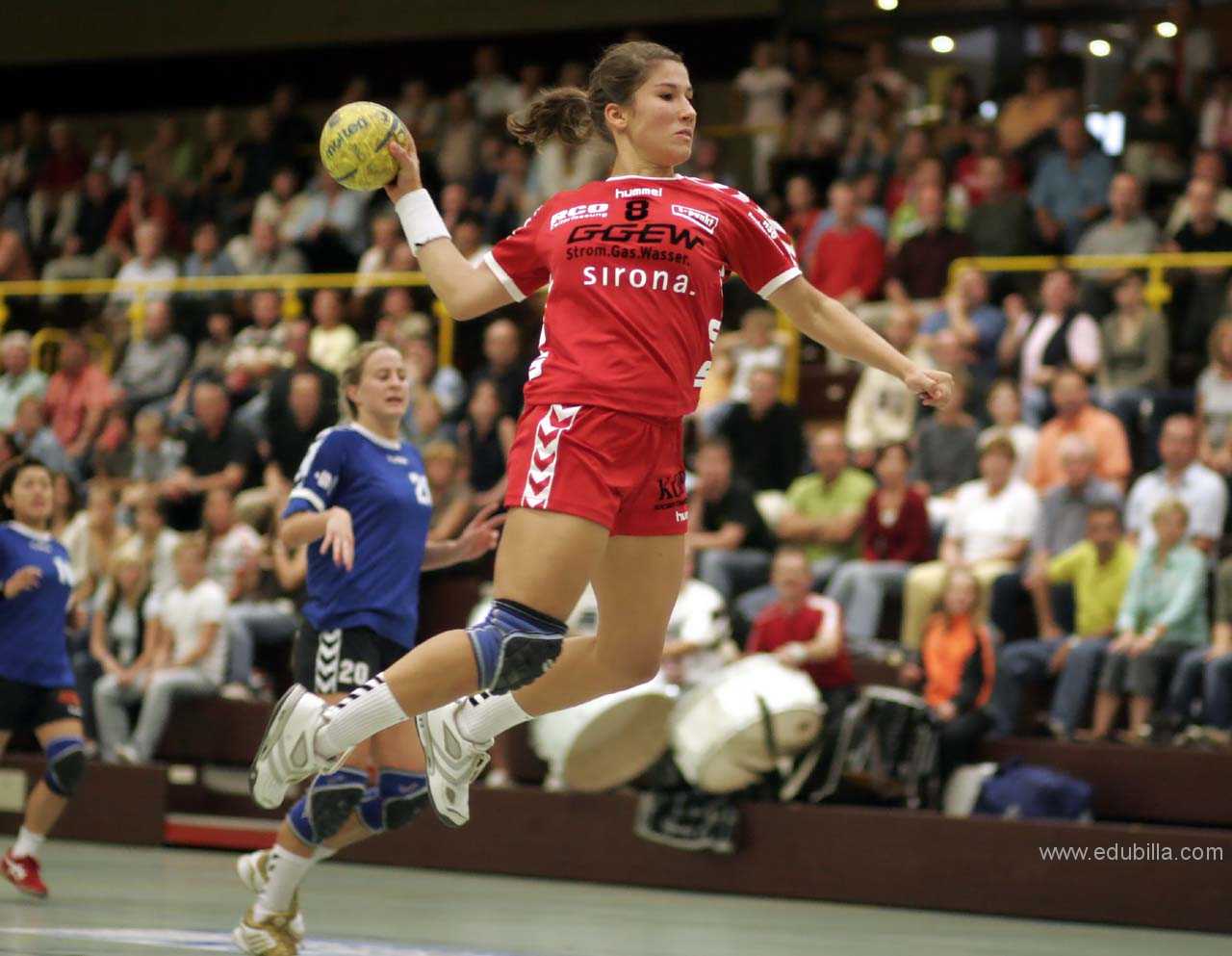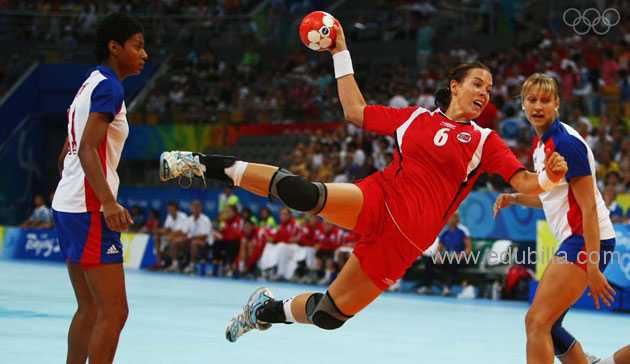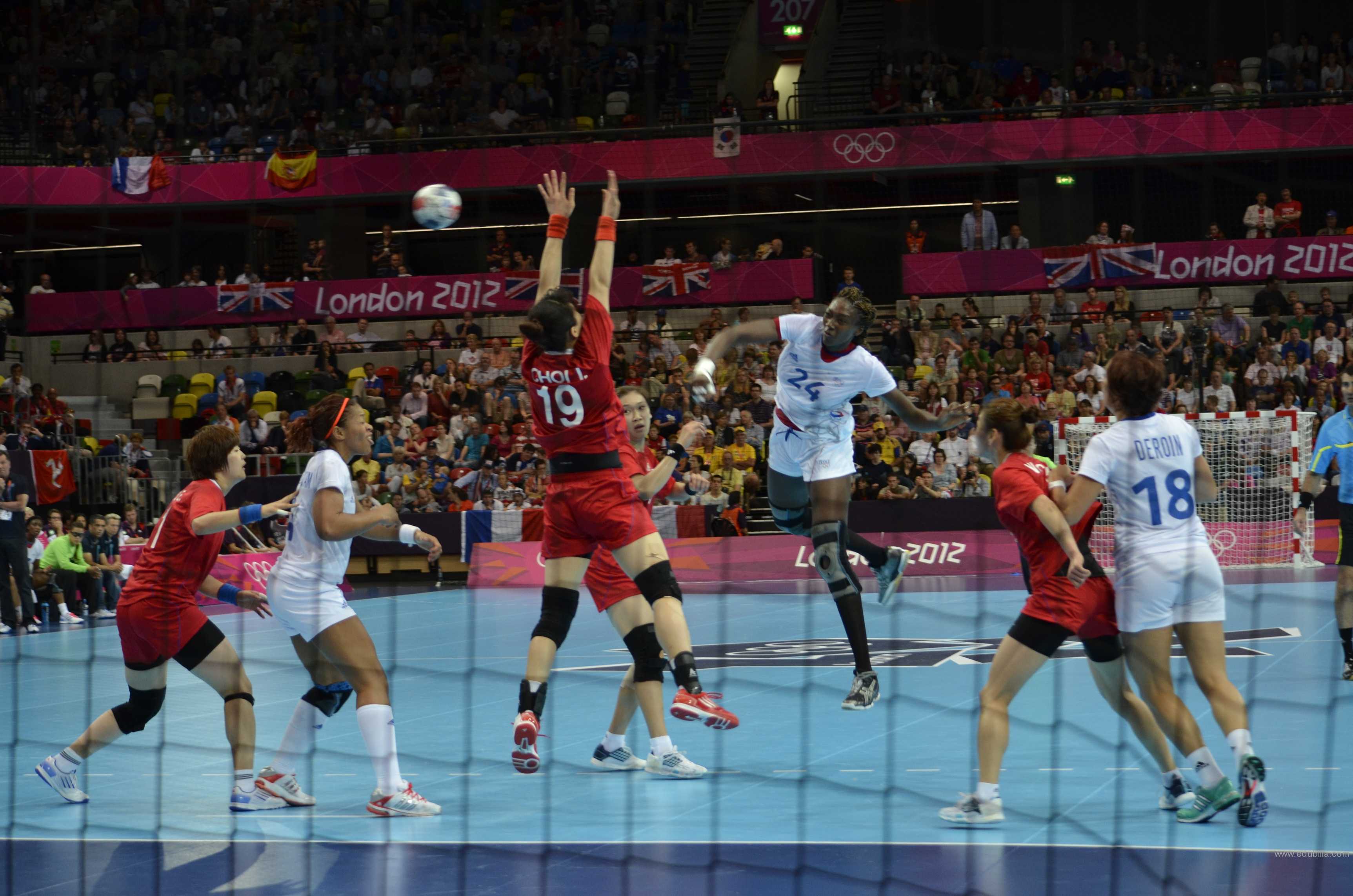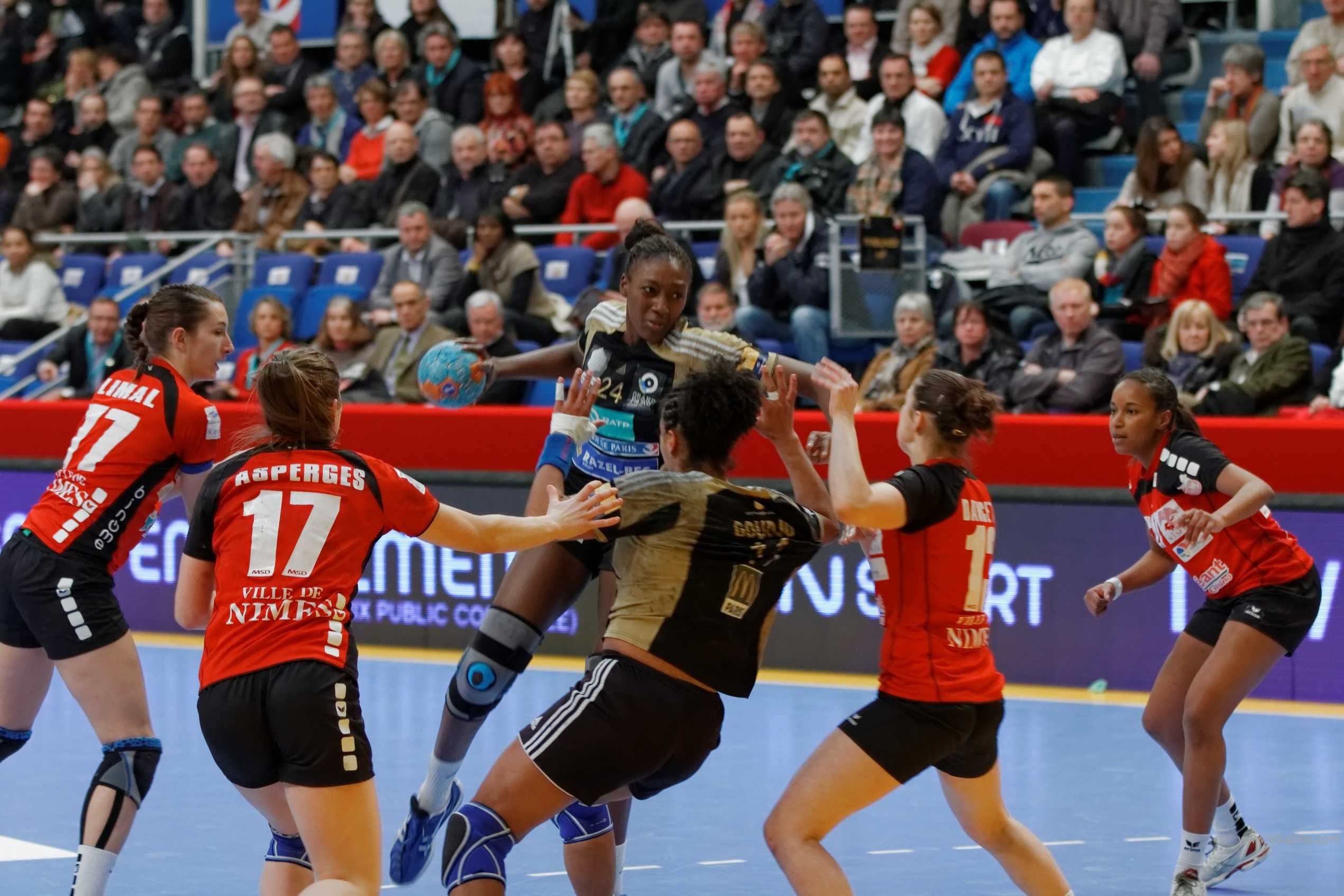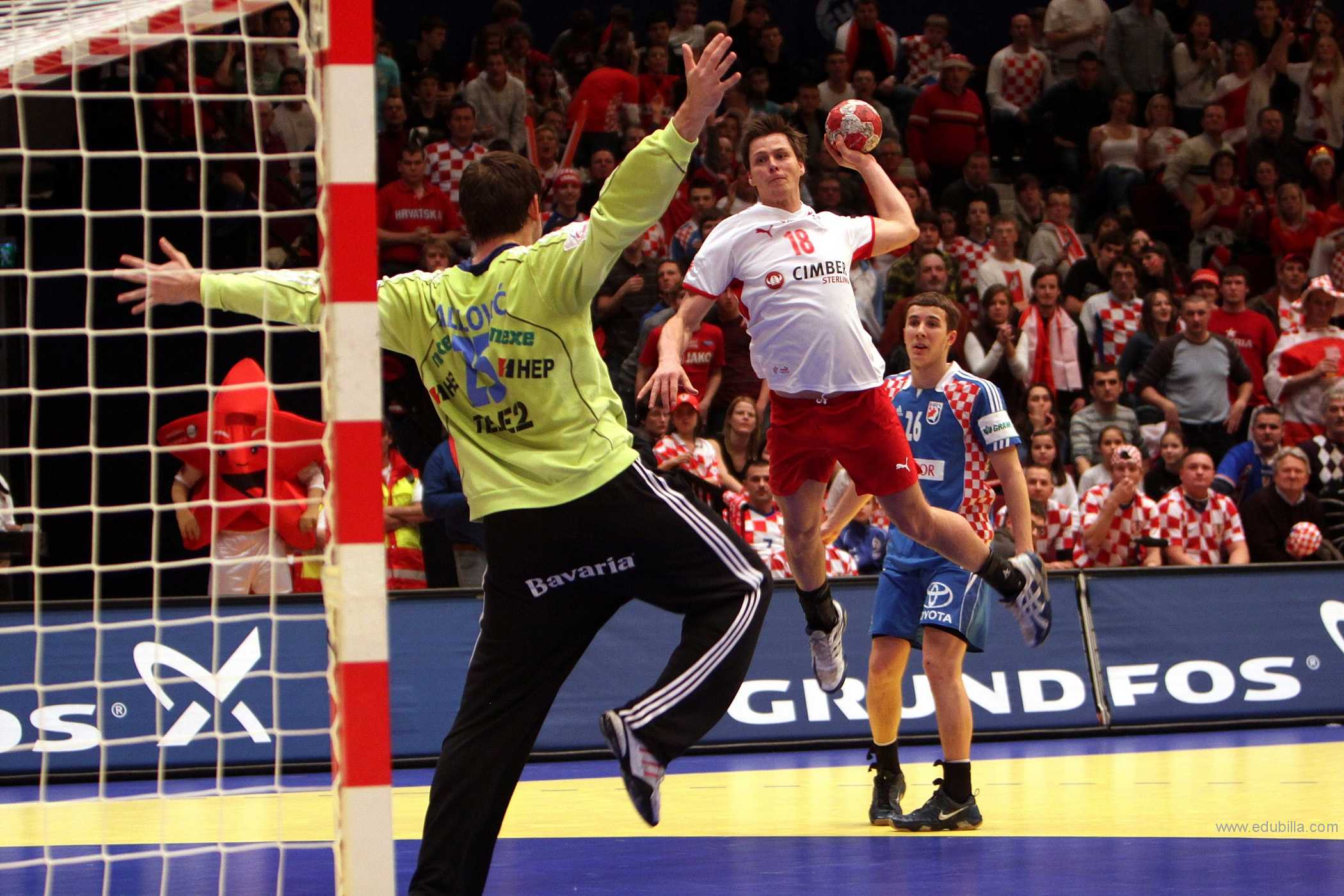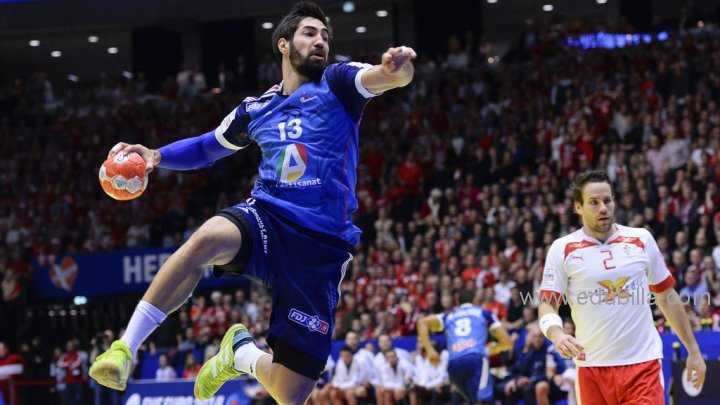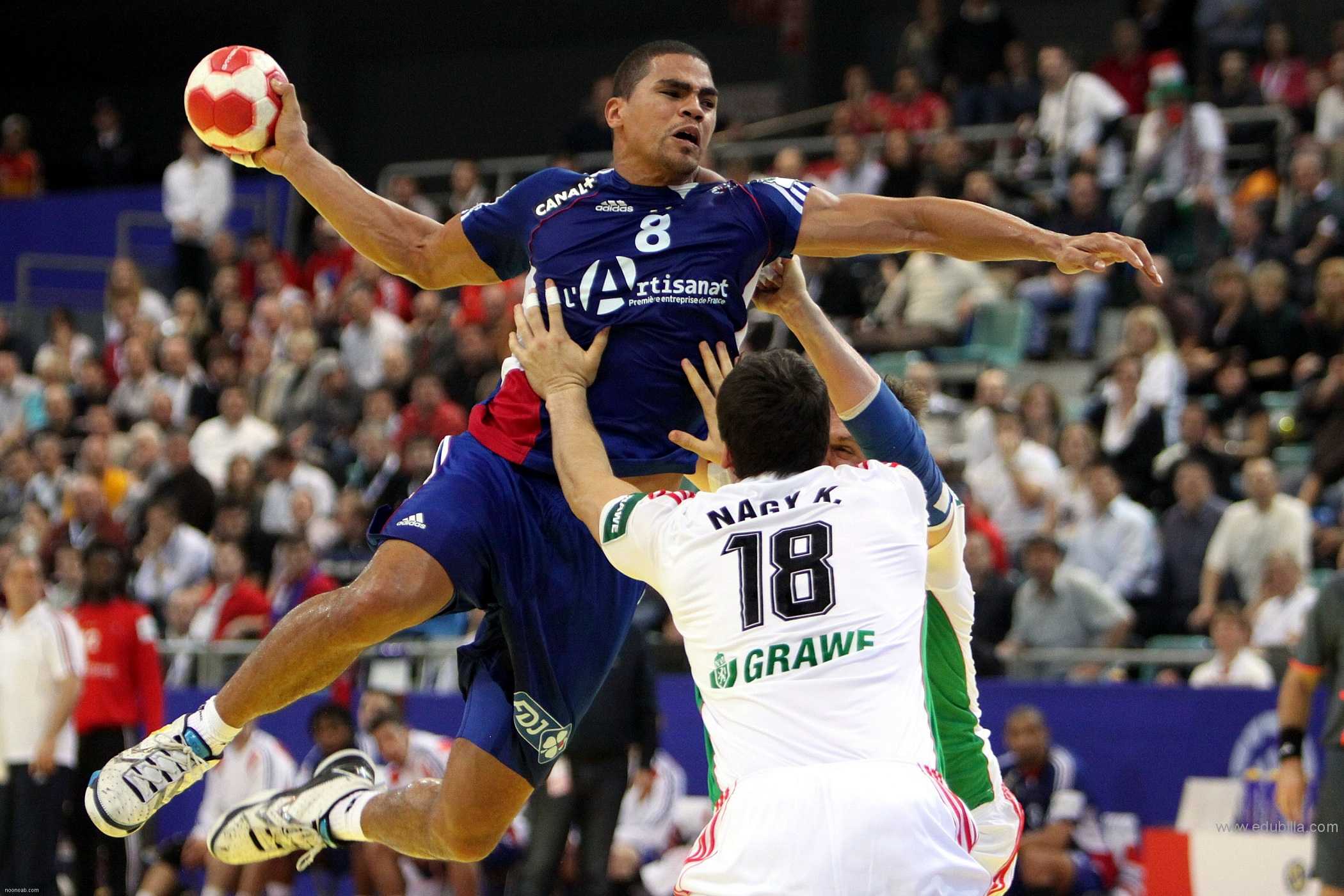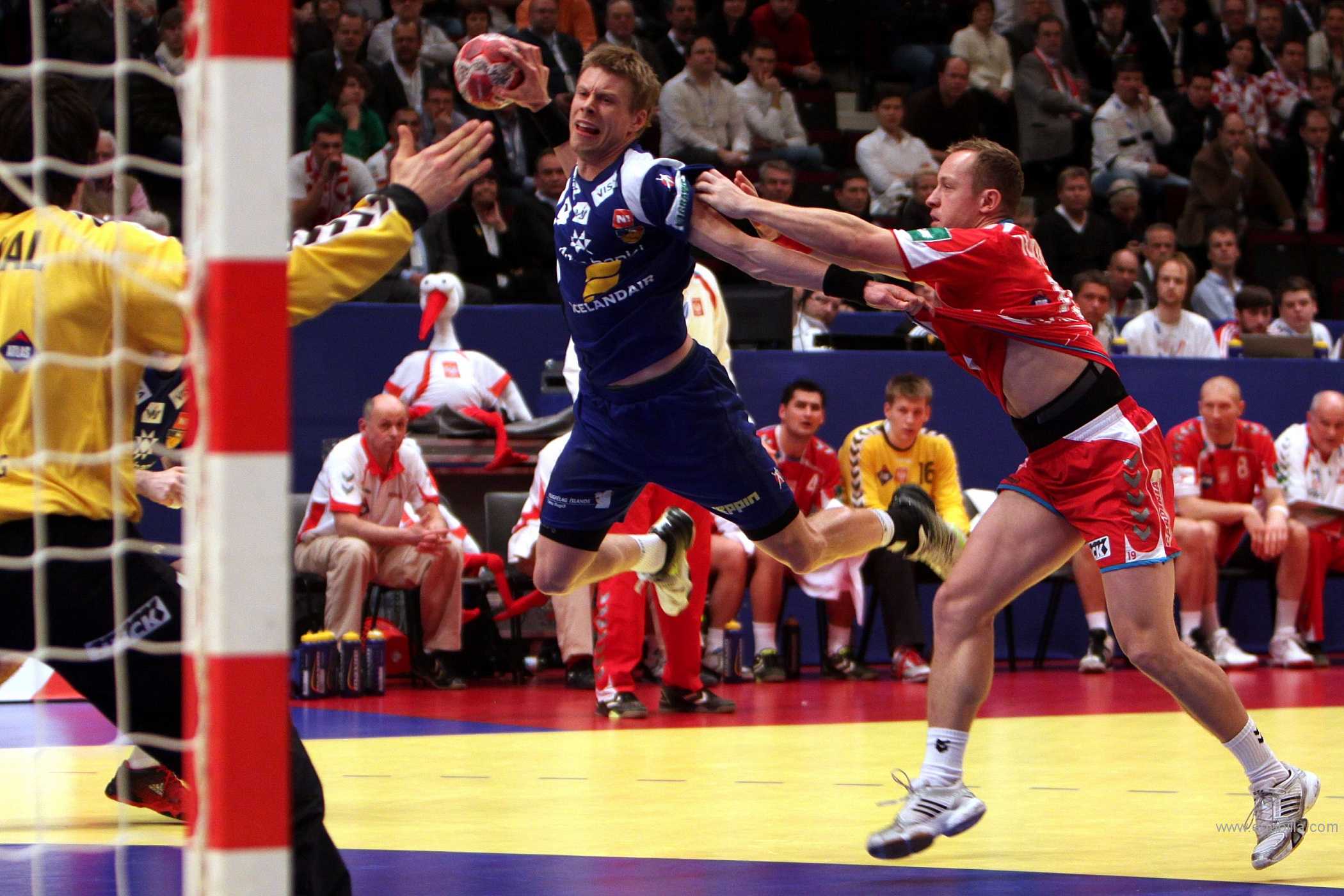
Overview Of Handball
Handball (also known as team handball, Olympic handball, European team handball, European handball, or Borden ball) is a team sport in which two teams of seven players each (six outfield players and a goalkeeper) pass a ball using their hands with the aim of throwing it into the goal of the other team. A standard match consists of two periods of 30 minutes, and the team that scores more goals wins.
Modern handball is played on a court 40 by 20 meters (131 by 66 ft), with a goal in the center of each end. The goals are surrounded by a 6-meter zone where only the defending goalkeeper is allowed; the goals must be scored by throwing the ball from outside the zone or while "jumping" into it. The sport is usually played indoors, but outdoor variants exist in the forms of field handball and Czech handball (which were more common in the past) and beach handball (also called sandball). The game is quite fast and includes body contact, as the defenders try to stop the attackers from approaching the goal. Goals are scored quite frequently; teams typically score between 20 and 35 goals each.
The game was codified at the end of the 19th century in northern Europe, chiefly in Scandinavia and Germany. The modern set of rules was published in 1917 in Germany, and had several revisions since. The first international games were played under these rules for men in 1925 and for women in 1930. Men's handball was first played at the 1936 Summer Olympics in Berlin as outdoors, and the next time at the 1972 Summer Olympics in Munich as indoors, and has been an Olympics sport since. Women's team handball was added at the 1976 Summer Olympics.
The International Handball Federation was formed in 1946, and as of 2013 has 174 member federations.The sport is most popular in continental Europe, whose countries have won all medals but one in men's world championships since 1938, and all women's titles until 2013, when Brazil broke the series. The game also enjoys popularity in Far East, north Africa and Brazil.
Game Rules
The Playing Court: The court measures 20 meters (65' 7") by 40 meters (131' 3"). The court is larger than a basketball court, but the length may be shortened when space is limited. The goal area line, or 6-meter line (19' 8"), is the most important line. No one except the goalie is allowed to stand in the goal area. The goal opening is 2 meters by 3 meters. Players may jump into the area if the ball is released before landing in the area.
The Ball: Team handball is played with a 32-panel leather ball. For women, the ball is 54 to 56 centimeters and 325 to 400 grams. For men, it is 58 to 60 centimeters and 425 to 475 grams.
Number of Players: There are seven players on each team (six court players and one goalie). A maximum of 12 players may dress and participate in a game for each team. Substitutes may enter the game at any time through own substitution area as long as the player they are replacing has left the court.
Uniform of the Players: Player numbers are 1 to 20. Uniform shirts and shorts are the same color. The goalkeeper must wear a different color shirt from teammates and opponents. No jewelry is allowed.
Referees: There are two referees, a court referee and a goal line referee. Referees have complete authority: Their decisions are final. The referees are assisted by a timer and a scorer.
Duration of the Game: For players 18 years and over, the game consists of 2, 30-minute halves with 10-minute half-time. For tournament and youth games 2, 15-minute or 2, 20- minute halves. This is running time except for injury or one team time-out per half. The teams change benches at half-time. The game ends in a tie unless the game demands a winner. (Tournament rules dictate that a winner must be determined.) Overtime consists of 2, 5-minute periods).
Passive Play: It is illegal to keep the ball in a team's possession without making a recognizable attempt to attack and to try to score. In other words, a team cannot stall (free-throw awarded to the other team).
Throw-Off: A throw-off is taken by the team that wins the coin toss and chooses to start the game with the ball. Each team must be in its own half of the court with the defense 3 meters away from the ball. Following a whistle, the ball is passed from center court to a teammate and play begins. Throw-off is repeated after every goal scored and after half-time.
Scoring: A goal is scored when the entire ball crosses the goal line inside the goal. A goal may be scored from any throw (free-throw, throw-in, throw-off, goal-throw).
Playing The Ball
A player is allowed . . . -To run with the ball for 3 steps -To hold the ball for 3 seconds -Unlimited dribble with 3 steps allowed before and after dribbling (no double-dribble).
A player is NOT allowed . . .
-To endanger an opponent with the ball.
-To pull, hit or punch the ball out of the hands of an opponent.
-To contact the ball below the knee.
-To dive on the floor for a rolling or stationary ball.
Defending the Opponent: A player is allowed to use the torso of the body to obstruct an opponent with or without the ball. However, using the outstretched arms or legs to obstruct, push, hold, trip or hit is NOT allowed. The attacking player is not allowed to charge into a defensive player.
Throw-In: A throw-in is awarded when ball goes out of bounds on the sideline or when the ball is last touched by a defensive player (excluding the goalie) and goes out of bounds over the endline. The throw-in is taken from the spot where the ball crossed the sideline, or if it crossed the endline, from the nearest corner. The thrower must place one foot on the sideline to execute the throw. All opposing players must stay 3 meters away from the ball.
Referee Throw: A referee throw is awarded when . . . The ball touches anything above the court after a simultaneous infringement of the rules after simultaneous possession of the ball.
The Referee throws the ball vertically between two opposing players. The jumping players may grab the ball or tap it to a teammate. All other players must be 3 meters away from the throw. The referee throw is always taken at center court.
Free-Throw: For a minor foul or violation, a free-throw is awarded to the opponent at the exact spot it took place. If the foul or violation occurs between the goal area line and the 9-meter line, the throw is taken from the nearest post outside the 9-meter line. The thrower must keep one foot in contact with the floor, then pass or shoot.
7-Meter Throw: The 7-meter throw is awarded when . . .
A foul destroys a clear chance to score
The goalie carries the ball back into his or her own goal area
A court player intentionally plays the ball to his or her own goalie in the goal area and the goalie touches the ball
A defensive player enters his or her goal area to gain an advantage over an attacking player in possession of the ball.
All players must be outside the free-throw line when the throw is taken. The player taking the throw has 3 seconds to shoot after referee's whistle. Any player may take the 7-meter throw.
Goal-Throw: A goal-throw is awarded when . . . The ball rebounds off the goalkeeper over the endline The ball is thrown over the endline by the attacking team.
The goalie takes the throw inside the goal area and is not restricted by the 3-step/3-second rule.
Progressive Punishments:
Progressive Punishments: Pertain to fouls that require more punishment than just a free-throw. "Actions" directed mainly at the opponent and not the ball (such as reaching around, holding, pushing, hitting, tripping and jumping into an opponent) are to be punished progressively.
Warnings (yellow card): The referee gives only one warning to a player for rule violations and a total of three to a team. Exceeding these limits results in 2-minute suspensions thereafter. Warnings are not required prior to giving out a 2-minute suspension. 2-minute suspensions awarded for . . . -Serious or repeated rules violations -Unsportsmanlike conduct -Illegal substitution. -The suspended player's team plays short for 2 minutes.
Disqualification and Exclusion (red card): A disqualification is the equivalent of three, 2-minute suspensions. A disqualified player must leave court and bench, but the team can replace player after the 2-minute suspension expires. An exclusion is given for assault. The excluded player's team continues short one player for the rest of the game.
Detailed Handball Rules Can Be Downloaded From Documents
Equipments Need For Handball
Ball:
The ball, with a leather casing, ranges in circumference from 58 to 60 centimetres for men and 54 to 56 for women. It weighs 425 to 475 grams for men, 325 to 400 for women.
Shoes:
For handball any particular form of sports shoes is useful, but there are specialised shoes which are available as well. These shoes are not used for national for inter-state meets, but are reserved for international tournaments.
Gloves:
GlovesIn a game of handball, gloves play a crucial role to protect the hand while catching a fast flying handball. The game be played without the help of gloves for sure, but the risk of calluses and bruises always remain. There is also a potential danger of injuring the finger or the hands. The gloves meant for handball are specially made to offer protection from the force of the incoming ball, so a typical pair of winter gloves is not adequate at all. As per types of handball gloves; there are two such types: full-coverage and partial-coverage.
For new entrants in the sports are forced to use full coverage gloves that the cover the entire hand, including the finger. This helps to protect the finger while playing the game. Experienced players, who are used to handling the fast moving handball, can also wear the partial coverage gloves that leave the finger unexposed. One of the advantages of exposed fingers is that it offers control and precision when throwing and catching the ball. In order to properly handle the ball, the size and fitting of the gloves is extremely crucial.
Protective Eye Wear:
This is absolutely for safety purpose. As the game of handball is played with high speed, so the risk to the eye always remains. So in order to avert such untoward incident the protective eye wear must be worn. Goggles are the best eye protections that can be purchased for game of handball. The goggles must be selected with care as and it must ensure best protection to the eye and offer comfort as well.
Court:
The court for handball is 40 metres long and 20 metres wide. A centre line across it divides it into two equal courts, with a goal area at each end. The goal area is D-shaped, arcing from the corners to a straight line six metres in front of the goal. The arcing sides similarly create a six-metre distance from the nearest part of the goal at all points.
History Of Handball
Handball is a fast-paced team game that was first played in Scandinavia and Germany at the end of the 19th century.
European origins:
The modern game of handball was first played towards the end of the 19th century in Scandinavia and Germany. Field handball was first recognised at the turn of the century and G. Wallström introduced the sport of "handball" to Sweden in 1910.
Rival codes:
Between 1938 and 1966 both forms of handball were played at separate World Championships: an outdoor, 11-a-side game played on a football pitch and a new 7-a-side indoor version preferred by the Scandinavians.
Olympic history:
After 1936, field handball was no longer played at the Games, except as a demonstration sport in 1952 in Helsinki. Indoor handball was presented for the first time at the 1972 Olympic Games in Munich. Yugoslavia was victorious and won the first gold medal after a competition between 16 men’s teams.
The introduction of women’s handball to the Games took place in 1976 in Montreal. The Soviet Union won this first women’s Olympic competition, taking home two gold medals after the 11-team men’s competition and the six-team women’s one.
The Modern Era:
Handball as it is played today began in northern Europe in the late 19th century, when it emerged as the successor to such regionally popular games as raffball and Königsbergerball. Holger Nielsen of Denmark - who actually medaled in fencing and shooting at the first modern Olympic Games in 1896 - and German physical education teacher Max Heiser are credited with shaping the basic rules that would come to govern the sport. The International Amateur Handball Federation was established in 1928; it was replaced in 1946 by the International Handball Federation, which continues today as the sport's world governing body.
Handball Today:
In recent decades, the sport has migrated from its ancestral homeland in northern Europe to parts of the world where it once was unknown. It has made big gains in Asia, as evidenced by the Koreans' Olympic success: Both the women and men medaled at the 1988 Seoul Games, taking the gold and silver, respectively. The women won the gold again four years later in Barcelona.
Handball enthusiasts have had more difficulty in importing their sport to the Americas. It has caught on in a few countries - notably Brazil and Argentina - but remains a curiosity in the United States, where it is often confused with the racquetball-style recreational sport of the same name.
Handball seemed to be gaining a foothold in the 1990s when the NCAA classified it as an "emerging sport" for women. It was hoped at the time that schools would form varsity handball teams in order to help satisfy their Title IX obligations, but 10 years later, little progress has been made. In fact, the NCAA's Committee on Women's Athletics is threatening to remove handball from its roster of emerging sports in 2008 if no growth is seen. In a news release dated Sept. 14, 2007, the CWA included handball, along with archery, badminton and synchronized swimming, on a list of sports that "show no steady progress in sponsorship and have less than ten institutions sponsoring the sport at the varsity level."
Origin Of Handball
There is evidence of ancient Roman women playing a version of handball called expulsim ludere.There are records of handball-like games in medieval France, and among the Inuit in Greenland, in the Middle Ages. By the 19th century, there existed similar games of håndbold from Denmark, házená in the Czech Republic, hádzaná in Slovakia, gandbol in Ukraine, and torball in Germany.
The First International Games:
The modern set of rules was published on 29 October 1917 by Max Heiser, Karl Schelenz, and Erich Konigh from Germany. After 1919 these rules were improved by Karl Schelenz. The first international games were played under these rules, between Germany and Belgium for men in 1925 and between Germany and Austria for women in 1930.
The First Handball Team:
Men's field handball was played at the 1936 Summer Olympics in Berlin. During the next several decades, indoor handball flourished and evolved in the Scandinavian countries. The sport re-emerged onto the world stage as team handball for the 1972 Summer Olympics in Munich. Women's team handball was added at the 1976 Summer Olympics. Due to its popularity in the region, the Eastern European countries that refined the event became the dominant force in the sport when it was reintroduced.
First competition:
The International Amateur Handball Federation (IAHF) was set up in 1928 on the occasion of the Olympic Games in Amsterdam, leading to the first Field Handball World Championships being played in Germany in 1938, following its appearance at the 1936 Berlin Games.
Olympic Debut:
Handball made its Olympic debut at the Games of the XI Olympiad, Berlin 1936. This was the grass version with 11 players. The sport was then not included on the programme, except as a demonstration sport in Helsinki in 1952. It reappeared in its indoor version with seven players at the Games of the XX Olympiad, Munich 1972. Women’s handball made its appearance at the Games of the XXI Olympiad, Montreal 1976.
Governing Bodies
International Handball Federation (IHF):
The International Handball Federation (IHF) is the administrative and controlling body for international team handball and has 159 national member federations.
In 1926, the Congress of the International Amateur Athletics Federation nominated a committee to draw up international rules for field handball. The International Amateur Handball Federation was formed in 1928, and the International Handball Federation was formed in 1946.
The International Handball Federation organised the men's world championship in 1938 and every 4 (sometimes 3) years from World War II to 1995. Since the 1995 world championship in Iceland, the competition has been every two years. The women's world championship has been played since 1957. The IHF also organizes women's and men's junior world championships. By July 2009, the IHF listed 166 member federations - approximately 795,000 teams and 19 million players.
The rules:
Handball is a fast-paced game involving two teams of seven players who pass, throw, catch and dribble a small ball with their hands while trying to score goals. The team with the most goals wins the game. A game consists of two 30-minute halves with a 10-minute half-time break.
Knockout tournament:
Teams are placed into two pools of six for both men and women. Each team plays the other teams in that pool. The top two teams in each pool proceed to the semi-finals. The remaining teams play classification matches for fifth place and lower. Semi-final winners play for the gold and silver medals. Semi-final losers play for the bronze.
Munich and Montreal:
Handball (the indoor version) was first present in the 1972 Munich Games. A competition involving 16 men’s teams was staged with Yugoslavia winning the first Olympic gold medal. A women’s event was then added at Montreal in 1976.
Events:
World National championships:
IHF World Men's Handball Championship
IHF World Women's Handball Championship
IHF Men's Junior World Championship
IHF Women's Junior World Championship
IHF Men's Youth World Championship
IHF Women's Youth World Championship
Olympics:
Further information: Handball at the Summer Olympics
Further information: Handball at the Youth Olympic Games
World Club Championship:
IHF Super Globe
To Visit IHF Click Here
Awards Related To Handball
The IHF issues awards to organisations and individuals in recognition of their particular contribution to developing the sport of handball and the IHF.
These awards are:
Hans Baumann Trophy:
The Hans Baumann Trophy, which was endowed by the Spanish members of the IHF, commemorates the late President of the IHF (1950 to 1971), Hans Baumann. It is awarded to IHF member federations.
The Hans Baumann Trophy is awarded to a member federation every two years at the Ordinary Congress of the IHF. It is awarded for particular services to the development and spread of handball in the member federation’s own country and/or throughout the world.
IHF Badge of Merit:
The Badge of Merit is awarded to individuals who made an extraordinary contribution to the development of handball.
Levels:
The Badge of Merit is awarded at three levels: Bronze, Silver and Gold.
-IHF Bronze Badge of Merit
-IHF Silver Badge of Merit
-IHF Gold Badge of Merit
IHF Certificate of Merit:
The IHF Certificate of Merit is awarded to individuals working outside the International Handball Federation in recognition of their particular contribution to promoting the sport of handball.
The Certificate of Merit is a document signed by the IHF President. The recipient is selected by the Council at the recommendation of the Executive Committee and the certificate is awarded by the IHF President or his representative.
IHF Cup of Honour and certificate:
The IHF Cup of Honour and a corresponding certificate is awarded to eminent personalities as well as national and international federations.
The Cup of Honour recognises extraordinary contributions to the development of the sport of handball.
The recipient is selected by the Executive Committee and the cup together with the certificate awarded by the IHF President.
IHF Olympic Order:
The Council of the IHF is entitled and has the duty to suggest to the IOC eminent personalities for the award of the Olympic Order in recognition of their outstanding merit and success in the development of handball in their own country, their many years of close collaborative links with the IHF and their dedicated service to the Olympic Movement.
IHF Plaque of Merit:
The Plaque of Merit is awarded to institutions and organisations outside the IHF.
Levels:
There are two levels: gold and silver.
-Gold Plaque of Merit
-Silver Plaque of Merit
IHF Referee's Badge of Honour:
The Referee’s Badge of Honour is awarded at three levels: bronze, silver and gold.
- Bronze Referee's Badge of Honour
2 Silver Referee's Badge of Honour
-Gold Referee's Badge of Honour
IHF Referee's Diploma of Honour:
Referees who participated in a World Championship (Men and/or Women) or in Olympic Handball Tournaments shall receive the Referee’s Diploma of Honour upon termination of their international career.
The diploma is presented by the PRC president or his representative.
IHF Ring of Honour:
The Ring of Honour may be awarded on special occasions (personal anniversary, selection as the World Handball Player of the Year, etc.) to outstanding individuals for their exceptional contribution to the sport of handball.
The Ring of Honour is made of gold and is specially engraved.
The recipient is selected by the Council at the request of the Executive Committee, and the Ring of Honour is awarded by the IHF President, one of the Vice-Presidents or the Secretary General.
IHF World Player of the Year:
The IHF World Player of the Year is an handball award given annually to the player who is considered to have performed the best in the previous season, both at club and internacional competitions. It is awarded based on votes Fans, media and an IHF expert group.
Danish Championship:
The Danish Handball League, officially known as Jack & Jones Ligaen for sponsorship reasons, is the men's top Danish professional handball league. The winners of the Danish Handball League are recognised as the Danish handball champions. The current champions are KIF Kolding, who gained their twelfth title in June 2009 defeating previous champions FCK Håndbold in playoff finals.
Danish Cup:
The Danish handball cup (Danish: Landspokalturneringen i håndbold) is the nationwide cup tournament for handball teams of Denmark. The competition has been played annually since 1964.
ASOBAL Cup:
The Copa ASOBAL is an annual cup competition for Liga ASOBAL teams. It was first played for in 1990 and is contested by the top four teams at the end of the first half of the Liga ASOBAL season.
Spanish Supercup:
The Supercopa ASOBAL or the Supercopa de España de Balonmano is an annual cup competition for Spanish handball teams. It is organised by the Liga ASOBAL. It was first played for in 1985 and is disputed between the Liga ASOBAL champions and the winners of the Copa del Rey de Balonmano. It is played as a single match, at a neutral venue and in different cities every year.
Spanish Cup:
The Copa del Rey de Balonmano is an annual cup competition for Spanish handball teams. Organized by the Liga ASOBAL. It was originally known as the Copa del Generalísimo and was renamed Copa del Rey de SM El Rey in 1975. It was the first nationwide handball competition played in Spain, and was first played for in 1957.
Sample Documents Of Handball
-Lance Armstrong

